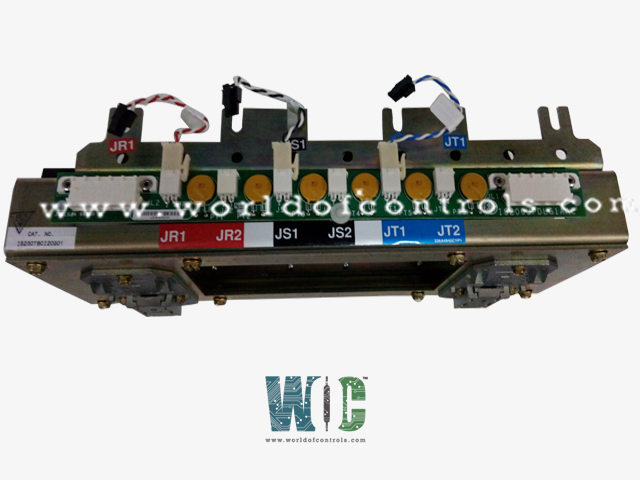SPECIFICATIONS
Part No.: IS230TBCI2CG01
Manufacturer: General Electric
Product Type: Contact Input Terminal Board
Size: 33.02 cm high x 10.16 cm wide
Temperature Operating: -30 to 65 o C
Input filter: Hardware filter, 4 ms
Power consumption: 20.6 watts
Temperature rating: 0 to 60 oC
Availability: In Stock
Country of Manufacture: United States (USA)
Series: Mark VI
Functional Description
IS230TBCI2CG01 is a Contact Input Terminal Board developed by GE. It is a part of Mark VI control system. The board is designed to facilitate the connection and management of multiple input signals. It is capable of accepting 24 dry contact inputs, which are essential for monitoring and controlling various processes within the system. The inputs are wired to the TBCI using two barrier-type terminal blocks, ensuring secure and reliable connections and minimizing the risk of loose or faulty wiring.
Features
- Requires DC power to excite the contacts. This power is wired directly into the TBCI, ensuring that the contacts can properly transmit signals to the system. The integration with the Mark VI system is enhanced by the use of PDIA I/O packs. Depending on the system configuration, one, two, or three PDIA packs can be plugged, providing the necessary flexibility to tailor the system to specific operational requirements and levels of redundancy.
- For proper integration with the Mark VI system, it must be the C version of the board. This version ensures the correct mechanical alignment of connector JT1 with the I/O pack mechanical support, guaranteeing a secure and precise fit. The alignment is critical for maintaining the integrity of the connections and ensuring reliable communication between the TBCI and the PDIA packs.
- Equipped with noise suppression circuitry to protect against surge and high-frequency noise, maintaining signal integrity and preventing erroneous data transmission due to electrical interference. By supporting multiple PDIA packs, the TBCI enhances the system's redundancy and reliability. In configurations with two or three PDIA packs, the system can continue to operate even if one pack fails, ensuring continuous monitoring and control capabilities.
- The ability to handle 24 dry contact inputs and integrate with various system configurations makes the it a versatile component suitable for a wide range of industrial applications. Its integration with PDIA I/O packs and the requirement for precise mechanical alignment ensure that it meets the stringent demands of modern industrial automation systems.
Wiring
- The wiring configuration of the Contact Input Terminal Board is designed for ease of maintenance and reliability in signal transmission. The board accepts 24 dry contact inputs, which are wired directly to two I/O terminal blocks mounted on the terminal board. These terminal blocks are secured with two screws each, providing a stable and secure connection. For ease of maintenance, the terminal blocks can be unplugged from the board when necessary, allowing for quick and efficient service or replacement.
- Each terminal block contains 24 terminals, each capable of accepting wires up to #12 AWG. This capacity allows for a variety of wiring configurations and ensures that the board can handle the necessary electrical load without issue. Additionally, to maintain signal integrity and minimize electrical noise, a shield terminal strip is attached to the chassis ground and located immediately to the left of each terminal block. This grounding strip ensures that any electrical interference is safely diverted away from the signal paths.
Power Connection
- The excitation voltage necessary for the operation of the contact inputs is wired through plugs JE1 and JE2. These plugs are designed to provide a reliable and secure connection for the power supply, ensuring that the contacts receive a consistent excitation voltage for proper operation. The use of JE1 and JE2 plugs simplifies the wiring process and provides a standardized method for connecting the excitation voltage, enhancing both the reliability and maintainability of the system.
- The combination of secure terminal blocks, capable of handling robust wiring, and reliable power connection plugs, ensures that the TBCI can operate effectively in demanding industrial environments. The design considerations for wiring and power connections reflect the need for both durability and ease of maintenance, ensuring that the TBCI remains a dependable component within the Mark VI system.
World of Controls has the most comprehensive collection of GE Mark VI components. Please contact WOC as soon as possible if you require any extra information.
Frequently Asked Questions
What is IS230TBCI2CG01?
It is a Contact Input Terminal Board developed by GE
What happens if there is a mismatch in the ID information of the terminal board connector?
If the controller detects a mismatch in the ID information of the terminal board connector, a hardware incompatibility fault is created. This fault indicates that the connected board does not match the system's configuration requirements, prompting operators to address the compatibility issue.
Why is noise suppression circuitry important for the terminal board?
Noise suppression circuitry is important because it protects the terminal board's inputs from surge and high-frequency noise, which can interfere with signal integrity. This ensures accurate and reliable operation of the terminal board even in electrically noisy environments.
What steps should be taken if a diagnostic alarm is triggered?
If a diagnostic alarm is triggered, operators should first identify the cause of the alarm by reviewing the diagnostic data. Depending on the issue, they may need to check the excitation voltage, inspect the inputs, verify TMR values, or address hardware compatibility. Taking corrective actions promptly ensures the system continues to operate reliably.
